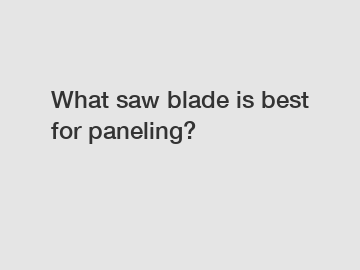What saw blade is best for paneling?
When it comes to paneling projects, choosing the right saw blade is crucial for achieving clean, accurate cuts. The type of saw blade you use can make a big difference in the quality of your finished project. With various saw blade options available on the market, it's essential to understand the different types and their specific purposes. In this article, we will discuss what saw blade is best for paneling and provide guidance on selecting the right blade for your project.
Blade Types for Paneling.
There are several types of saw blades that can be used for paneling projects, each with its own unique characteristics and advantages. The two most common types of saw blades used for paneling are rip blades and crosscut blades.

Rip Blades.
Rip blades are designed to cut with the grain of the wood. These blades typically have fewer teeth than crosscut blades and are ideal for making long, straight cuts in the direction of the wood grain. Rip blades are perfect for cutting solid wood panels and natural wood veneers. These blades are not suitable for cutting across the grain, as they can cause tear-out and splintering.
Crosscut Blades.
Crosscut blades are designed to cut across the grain of the wood. These blades have more teeth than rip blades and create clean, smooth cuts perpendicular to the wood grain. Crosscut blades are ideal for cutting plywood, MDF, particleboard, and other engineered wood products. These blades are not meant for ripping cuts along the grain, as they can cause binding and kickback.
Choosing the Right Blade.
When selecting a saw blade for paneling, it's essential to consider the type of material you will be cutting and the desired outcome of your project. If you are working with natural wood panels or solid wood, a rip blade may be the best choice. On the other hand, if you are cutting engineered wood products like plywood or MDF, a crosscut blade would be more suitable.
It's also important to consider the number of teeth on the blade. Blades with more teeth produce finer cuts, while blades with fewer teeth are better for faster, rougher cuts. For paneling projects that require precision and a smooth finish, a blade with a higher tooth count is recommended.
Additionally, the size and thickness of the paneling material should be taken into account when choosing a saw blade. Thicker materials may require a blade with a larger diameter to ensure a clean, straight cut.
Conclusion.
In conclusion, when it comes to paneling projects, choosing the right saw blade is essential for achieving professional results. Whether you are cutting natural wood panels or engineered wood products, selecting the appropriate blade type and tooth count can make a significant difference in the quality of your cuts. By understanding the characteristics of rip blades and crosscut blades, you can make an informed decision when selecting a saw blade for your paneling project.
Contact us.
If you have any questions or need further assistance in choosing the right saw blade for your paneling project, feel free to contact us. Our team of experts is here to help you find the perfect blade for your specific needs.
If you want to learn more, please visit our website diamond blade manufacturer, diamond blade manufacturer, diamond blade manufacturer.


